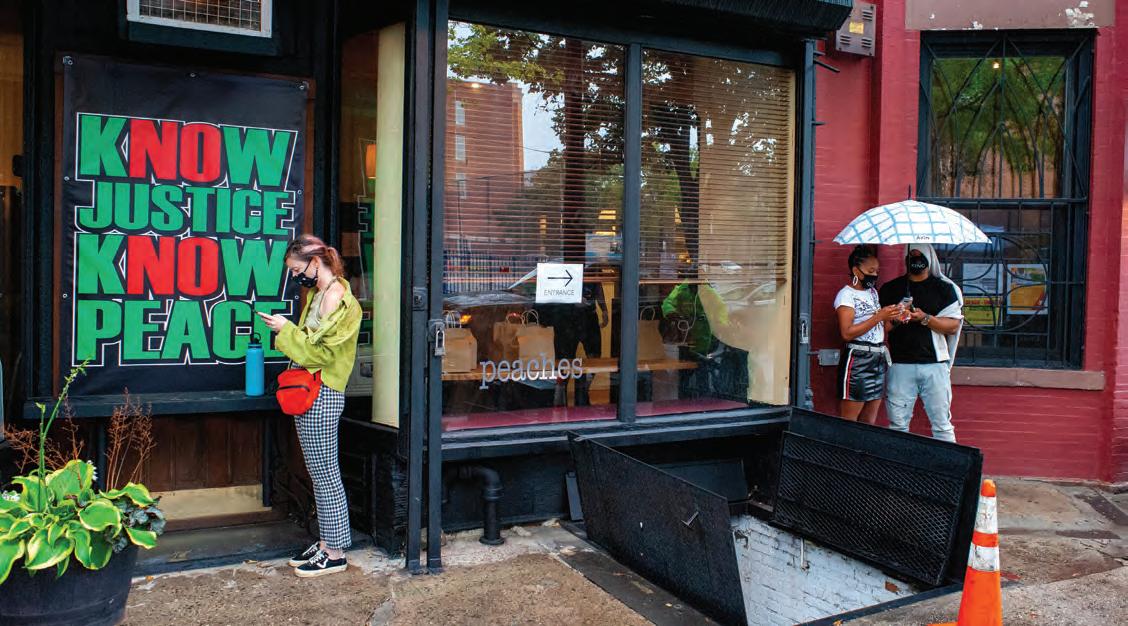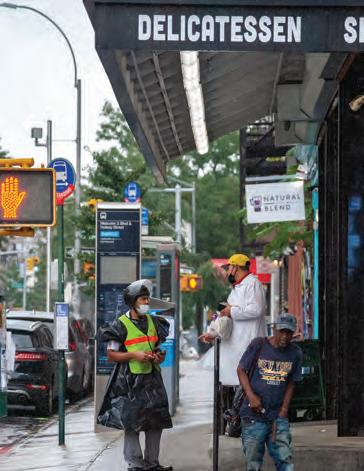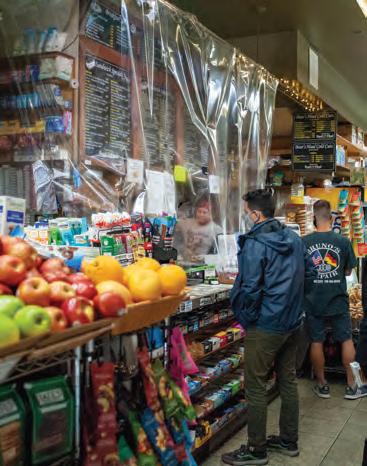
6 minute read
FOOD AND THE CITY How a pandemic birthed a more neighborly New York by Tafari Fynn
Brooklyn residents wait outside Peaches to pick up food.
Food and the city How a pandemic is birthing a more neighborly New York Story by Tafari Fynn, photos by Tobin Polk
Advertisement
The city of New York resembles a type of organism, one that is dependent on its organelle-like structures to function. Growing up in Brooklyn for all my nineteen years, I have come to recognize the pillars that define this city: The Metropolitan Transportation Authority (MTA), the varied governments and chambers of commerce, and the thousands of small businesses scattered throughout the five boroughs. While the phenomenon of New York City’s diversity and independence is often portrayed as derived from some mythical power source, it would cease to exist without its many social and economic systems, both formal and informal. Cities of this stature have exhibited various responses to the global COVID-19 pandemic. Starting in March of this year, I’ve observed the ways that New York and its inhabitants have coped with the world-wide health crisis. As hardships around the globe have produced mass outrage and grief, I’ve challenged myself to examine the intersections between the current fight for social justice and the viral pandemic, to address how they shape the universal expression of resilience.
My own experience began last March, with a swift return home from my university’s dormitory halls in the midst of national fear-shopping and stockpiling that emptied retail and bulk stores across the country. Supermarkets saw lines of shoppers that wrapped around city blocks; cleaning products became nearly impossible to find on shelves. This panic-based reaction shed light on our fragile access to resources in the city and the ways distribution of these necessities is informed by socioeconomic and racial circumstances. Widespread gentrification has inhibited access to quality produce and isolated resources in richer enclaves. In many neighborhoods that were once home primarily to residents of color, the influx of wealthy, white residents (and resultant overdevelopment) has destroyed old cultures and pushed out the people who sustained them. These cultures included implicit social guidelines and lifestyles, such as navigating through high-crime neighborhoods. It’s frustrating for New York natives, such as myself, to witness their city government invest in communities only upon the arrival of privileged occupants. Unequal food access can be used as a means of regulating the socio-demographics of particular populations, establishing invisible boundaries that divide a city based on race and class. This sort of racism — ingrained in the behavior of our institutions and fellow citizens — perpetuates poor diets and leads to health complications within Black and Brown communities. I’ve lived in Bedstuy for the past three years, a neighborhood comprised of Black working-class residents. The interdependent character of the neighborhood has secured the presence of small businesses, reinforcing a strong sense of community throughout the pandemic. Inner-cities in the United States all face issues of food 32
insecurity and dysfunctional food-assistance programs. The prevalence of food deserts in urban areas is often overlooked, especially in New York City. Its reliance on imported food products and lack of connectedness to food sourcing perpetuate a knowledge gap on the importance of food locality. Not only does locally sourced food conserve transportation resources, but it also equips communities with the agency and security of agricultural self-sufficiency. The South Bronx and Brooklyn are the two most notable food deserts in the city, providing mostly fast foods with little nutritional value. In June, as I explored my own neighborhood for the first time in weeks, following the peak of COVID-19 cases, I marveled at the sea of delis and bodegas packed with people seeking items for their meals. Attempting to access high-quality food in a food desert requires one to be able-bodied. I watched my elderly neighbors push carts piled high with shiny packaged goods from the closest affordable supermarket two miles away. It’s easy to disregard the fact that New York City contains food deserts because of the prevalence of organic and specialty grocers. These stores, however, ultimately serve only the consumers who can afford them, leaving thousands still in need.
The solutions proposed for improving food accessibility caused by the pandemic (ordering groceries through delivery services, eating take-out, etc.) are framed as convenient, but in practice they are not sustainable and not affordable for all. Because of this, many small businesses in Bedstuy remained open through the worst spike of the pandemic. Owner of Greedi Kitchen, Latisha Daring, has continued to bring vegan comfort food to Bedstuy and the nearby neighborhood of Crown Heights. Her restaurant, along with Bedstuy Fish Fry, Café on Ralph, and Peaches are examples of iconic Black-owned establishments that have served the neighborhood well over the past few months. Latisha’s triumph to remain open during this time, in which thousands of small businesses have become extremely vulnerable, demonstrates a special kind of environmental resilience: perseverance in the face of unimaginable place-based circumstances. Similar acts of reliance can be found in chef Allison Arevalo’s successful efforts to sell fresh pasta out of her home in Park Slope, Brooklyn. Thadeaus Umpster, Bedstuy activist and community organizer, had concerns about the lack of available fresh produce earlier this winter. He collected food donations and placed a fridge full of organic items in New York’s first ever Free Fridge. Many Free Fridges have since popped up around Brooklyn and lower Manhattan as a means of supporting those who became unemployed as a result of the pandemic — adding extra support to an already barren food climate. These actions reflect how societal distress has transformed the mentality and habits of New Yorkers. To live in New York City is often to be individualistic; this period of uncertainty and confusion has sparked people to think more collectively. The murder of George Floyd and the ensuing Black Lives Matter protests have further contributed to New York City’s maturing identity. From fighting a virus to standing up to the violence and political clout of the largest police department in America, the city and its people embody the truest form of resilience, revealing their potential to sustain themselves during mass hysteria. Social media has helped spread awareness of the systematic oppression pervasive in all facets of American life. As disaster plasters newspaper headlines, I’ve been fortunate to witness the incredible adaptability of humans. This global chaos has produced many forms of solidarity and psychological resilience, all of which reflect our instincts to protect and prolong the lives of our fellow people. The pandemic has commenced a new period in world history. How people relate to their environment and social/kin networks has taken on entirely new forms. Household dynamics, work-life balance, and access to resources have morphed to accommodate current health precautions and safety procedures. The consequences of the pandemic have established new social expectations about how the actions of individuals affect others: New Yorkers have become more neighborly and overall more aware of their surroundings. The concept of social distancing has become a new social courtesy, a simple act that displays a form of decency and respect. Though many still debate the value of wearing face masks, we are nonetheless adopting more conscientious practices within society. I believe that the ability to coexist with change defines resilience.












